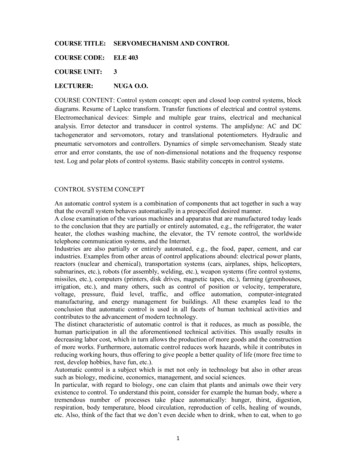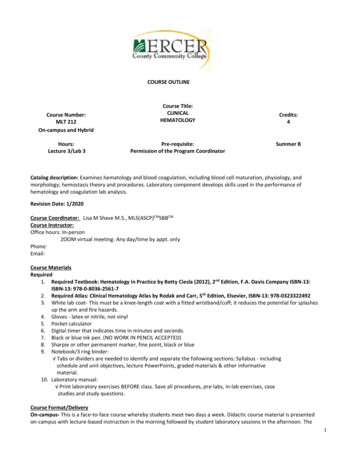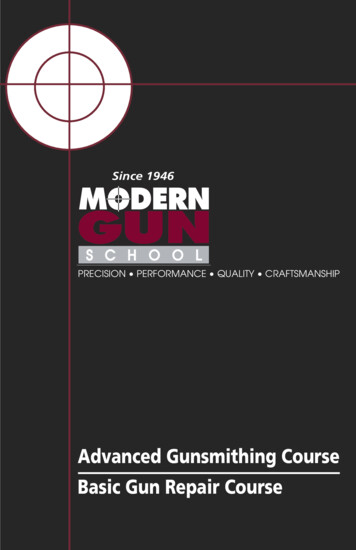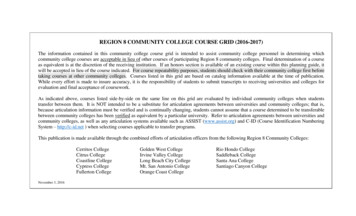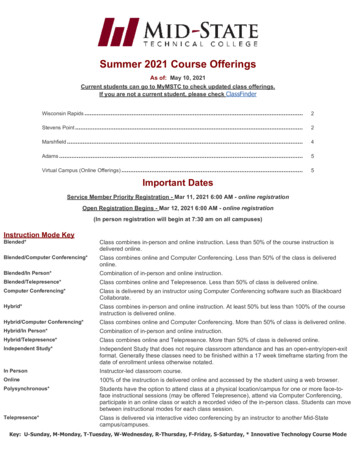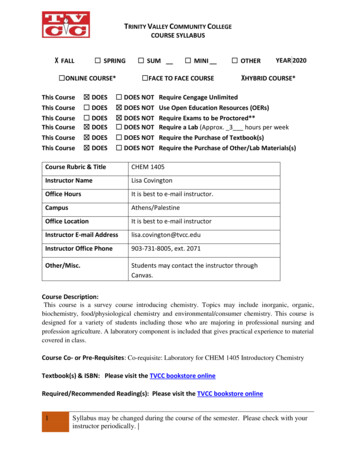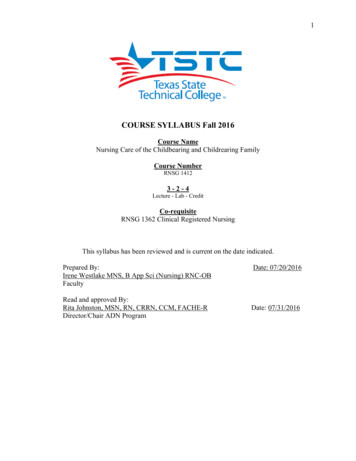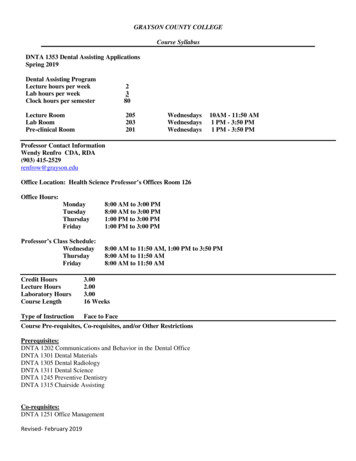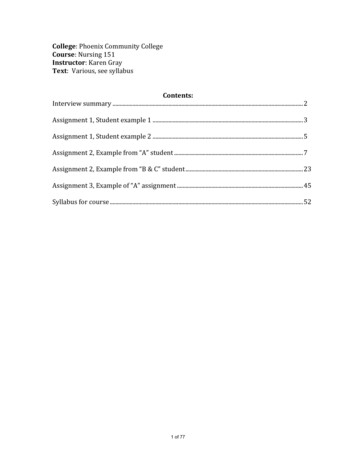
Transcription
:Interviewsummary . 2Assignment1,Studentexample1 . 3Assignment1,Studentexample2 . 5Assignment2,Examplefrom“A”student . 7Assignment2,Examplefrom“B&C”student . 23Assignment3,Exampleof“A”assignment . 45Syllabusforcourse . 521 of 77
PCCNURInterviewKarenGray,December Thiscourseinvolvesaconsiderableamountofreading. andtests n’tdohomework,butyoucan’tgetanAeither) andquizzes,sothosearewhatcounttowardthepass/fail Somehomeworksheassignsincludeso image,anatomy)o demandingassignment)o ueatendofsemester)o oralreports(inlab,withaPowerpointpresentation)o portfolio dfortheentireprogram3cases: ogyassignmentssent) Mostdemanding:CarePlan(twostudentsamplessent) sent)2 of 77
Body OrganizationAnatomical Locations & PositionsOn paper, define the following terms. Then using Google Images, “Anatomical Position”& “Body Cavities” find an image and locate the terms on the image. Print and turn inwith your definitions.Directions:1.2.3.4.5.6.7.8.9.Superior: body part closer to the headAnterior: towards the front of the bodyPosterior: towards the back of the bodyMedial: body part closer to the middle of the bodyLateral: body part away from the “midline” of the bodyProximal: body part closer to point of attachmentDistal: body part farther from point of attachmentVentral: same as anteriorDorsal: same as posteriorPlanes:1. Midsagittal Plane: divides body into right and left sides2. Transverse/Horizontal Plane: divides body into upper and lower parts3. Coronal/Frontal Plane: up and down plane, divides body into front and backCavities:1. Ventral Cavity Thoracic: separated by diaphragm from the abdominopelvic cavity Abdominal: includes most of small and large intestines, stomach, liver,gallbladder, spleen, kidneys Pelvic: enclosed by hip bones, contains urinary bladder and reproductiveorgans2. Dorsal Cavity Cranial: cavity that contains the skull Spinal: cavity that contains the vertebrae3. Abdominopelvic Cavity: extends from diaphragm to floor of pelvis3 of 77
4 of 77
Cardiovascular SystemDefine the following terms:1.2.3.4.Arrhythmia: a disturbance in the rhythm of the heartbeatBradycardia: slow heartbeat, 60 bpmCardiomegaly: medical condition, enlarged heartcyanosis: blue-ish color in skin due to lack of oxygen or defective hemoglobin inthe blood5. embolism: occlusion of a blood vessel by a blood clot (embolus)6. aneurysm: a permanent cardiac or arterial dilation usually caused by weakening ofthe vessel wall7. diastole: dilatation of heart in which chambers are filling with blood8. systole: contraction of the heart, blood in chambers is forced out9. ischemia: reduced blood supply, caused by vasoconstriction or obstacles toarterial flow10. phlebitis: inflammation of vein11. tachycardia: fast heartbeat, 100 bpm12. thrombus: moving blood clot (emboli)13. ventricular: pertaining to a ventricle14. fibrillation: uncontrolled twitching, quivering of atrium of heart, causes fast andirregular ventricular activity15. infarction: deprivation of blood supply, causing tissue to dieDefine the following Abbreviations:1.2.3.4.5.6.BP: blood pressureCAD: coronary artery diseaseCHF: chronic heart failureDVT: deep venous thrombosisECG/EKG: electrocardiogramMI: myocardial infarctionDefine the following root forms:1.2.3.4.5.Angio: blood vesselaorto: aortaarteri: arterycardio: heartisch: to hold back6. Myo: muscle7. Thrombo: clot8. Vascul: vessel9. Necr: death10. Sten: narrowWrite the medical term for the following meanings:5 of 77
1.2.3.4.5.A condition of narrowing of a blood vessel: peripheral artery diseaseInflammation of a vein: phlebitisA fast heartbeat: tachycardiaEnlargement of the heart: cardiomegalyA condition in which a blood clot obstructs a blood vessel: embolism6 of 77
MCCDNPNUR151 Nursing Theory and Science IPREPARATORY CARE PLAN FOR THE ADULT CLIENT(*) denotes section to be completed prior to clinicalStudent Name Block I "A" StudentCare Area 2004-1 Sex FMarital Status Married Allergies No Known Allergies / Patient has sensitivity to ASPIRIN Age 80Code Status Patient request no emergency medical procedures be institutedAdmitted from:home LTC Acute Care Other ER(*)Medical/Surgical Diagnosis:1. Congestive heart failure2. Bronchopneumonia3. Arteriosclerotic heart disease4. Osteoarthritis5. Constipation6. Edema7. Orthopnea8. Anorexia9. Pleural effusion10. Cardiomegaly11. Left ventricular hypertrophy7 of 77NUR151 Nursing Science Short Care Plan 1Revised 1/10/09
MCCDNPNUR151 Nursing Theory and Science I(*) Pathophysiology:(Textbook/source ) In your own words, describe textbook signs and symptoms associated with themedical/surgical diagnosis. If there is a surgical diagnosis, include the surgical pathophysiology (what will be different after surgery) Use reverse side ifnecessary.1.Congestive heart failure is the diagnoses given to impaired cardiac pumping with associated pulmonary congestion. Heartfailure and pulmonary congestion will be identified separately and the correlation between the two identified. Heart failure is notactually a disease but is a result of another cardiac or circulatory disease. Most notably, heart failure is associated with cardiovasculardiseases such as hypertension, coronary artery disease and myocardial infarction. Heart failure is identified by the signs andsymptoms related to ventricular insufficiency/dysfunction that result in circulatory dysfunction and fluid retention. Patients will likelyreport reduced exercise tolerance, fatigue, nocturia, chest pain, weight changes, dyspnea and painful or painless peripheral edema.Heart failure will show signs of both left and right ventricular insufficiency. Heart failure normally begins with signs from left sidedfailure; as the left ventricle is unable to completely expel blood into the systemic circulatory system it will begin to back up in the leftatrium and pulmonary circuit. The buildup of blood in the pulmonary circuit causes an increase in pulmonary pressure that causesfluid to cross over the pulmonary capillary bed into the interstitium and then the alveoli – this is evidenced by crackling in the lungs.The build up of fluid within the lungs promotes pulmonary congestion and edema. Right sided failure is normally an after effect ofleft sided failure. Long standing increased pulmonary hypertension can result in right-sided hypertrophy and failure. When the rightventricle fails to expel blood with enough pressure into the pulmonary circuit it will begin to back up in the right atrium and venouscirculatory system. Signs associated with right sided heart failure include jugular venous distention, hepatomegaly (enlargement ofthe liver), splenomegaly (enlargement of the spleen), vascular congestion of the GI tract and peripheral edema.Treatment for congestive heart failure is focused on decreasing symptoms, correcting ventricular changes, improving quality oflife and decreasing mortality and morbidity. Drug therapy normally includes diuretics, vasodilators, positive inotropes, painmanagement, and oxygen therapy. Response to treatments is key to reducing mortality. Recurring hospitalizations within 12 monthsfor heart failure increase mortality from 4.1% to 40%.Information on CHF was found in Medical Surgical Nursing, by Lewis, Heitkemper, Dirksen, O’Brien and Bucher.2.Arteriosclerotic heart disease is the diagnoses given to a type of coronary artery disease that involves the build up of plaque inthe coronary arteries. The disease is characterized by deposits of cholesterol and lipids within the intimal wall of the artery.Arteriosclerotic heart disease takes many years to develop and the endothelium of the artery has to be susceptible to disease from aprevious injury or disease. Arteriosclerotic heart disease then begins as just fatty streaks within the smooth muscle cells, then fibrousplaque forms due to the smooth muscle cell proliferation and finally a complicated lesion forms. Coronary artery disease takes many8 of 77NUR151 Nursing Science Short Care Plan 2Revised 1/10/09
MCCDNPNUR151 Nursing Theory and Science Iyears to develop and once it is best treated if caught early. Identifying risk factors and beginning treatment strategies early will resultin the most successful outcome. Risk factors include being a white, middle aged man, women over 65, family history, elevated serumlipid levels, hypertension, tobacco use, physical inactivity, diabetes, obesity and negative psychological states. As the diseaseprogresses signs of poor myocardial perfusion will be evident, eventually more severe ischemia or infarction could occur.Treatment for arteriosclerotic heart disease depends upon the disease state; early treatments include counteracting risk factorssuch as dietary changes to reduce fat intake, controlling blood pressure, abstaining from tobacco, reaching a healthy weight andproperly managing other diseases (i.e., diabetes). Drug therapies are also focused on counteracting risk factors such as cholesterollowering drugs and antiplatelet therapy. More invasive procedures to reopen blocked arteries include balloon angioplasty and stentplacement. Angioplasty involves feeding a small catheter into the afflicted artery and inflating a balloon within the restriction tocompress the blockage and dilate the vessel. A stent can also be placed in the blocked area instead of, or in addition too, theangioplasty as means to secure the blockage even further. A stent is an expandable mesh tube that stays in place within the blockageto maintain vessel patency.Information on arteriosclerotic heart disease was found in Medical Surgical Nursing, by Lewis, Heitkemper, Dirksen, O’Brien andBucher.3.Osteoarthritis is a slowly progressive noninflammatory disorder of the synovial joints. The exact idiopathic cause ofosteoarthritis is unknown, but secondary OA is caused by an event or condition that damages cartilage or otherwise destabilizes thejoint. Overuse of joints as seen in athletes is a common source of joint damage that could evolve into OA. Progression of OA causesthe articular cartilage to become less able to resist wear; a metabolic response within the chondrocytes makes it less able to repairdamage. Further changes in the cartilage cause fissures and erosion of the surfaces, as the cartilage is further destroyed the bonesurfaces are no longer cushioned from one another. Secondary inflammation may occur as the body attempts to remove small piecesof cartilege and bone debris within the joint. Osteoarthritis does not have any systemic symptoms; its effect is seen only in the jointsthat it impacts. Discomfort and stiffness in the afflicted joint(s) are the main symptoms but crepitation and deformity can result.The treatment of osteoarthritis is focused on pain control and preventing disability and increasing function. Rest and jointprotection, heat therapy for stiffness, management of weight or other factors that increase joint stress, and pain management are themost common treatments for OA. There is no cure for osteoarthritis.Information on osteoarthritis was found in Medical Surgical Nursing, by Lewis, Heitkemper, Dirksen, O’Brien and Bucher.9 of 77NUR151 Nursing Science Short Care Plan 3Revised 1/10/09
MCCDNPNUR151 Nursing Theory and Science IMedical/Surgical/Social/Cultural History: (Describe all recent, pertinent events, diseases, issues that will impact nursing care).Collect this data from the chart and the client interview; (Use back of page if needed)Patient medical history includes normal childhood ailments and recently multiple episodes of congestive heart failure within the last10 years. Patient was initially brought to the emergency room by her daughter with complaints of shortness of breath, and wassubsequently admitted. The patient carries several current diagnoses and/or history of ailments and diseases directly related to hercurrent congestive heart failure including; edema, arteriosclerotic heart disease and orthopnea. The patient also currently suffers frombronchopneumonia, anorexia and constipation. The patients’ surgical history includes a choloscystectomy at 65 year of age andbilateral cataract extraction at 78 years of age; success and current impacts from surgical interventions are unknown. The patient isvery active in her church and is a practicing protestant. The patient is a retired school teacher, and currently lives at home with herspouse whom is in poor health with an unknown condition. The patient has at least one child, a daughter who lives nearby, that assistswith parental care when needed. All children are reported living and in good health. The patient reports no famil
NUR151 Nursing Science Short Care Plan Revised 1/10/09 3 years to develop and once it is best treated if caught early. Identifying risk factors and beginning treatment strategies early will result in the most successful outcome. Risk factors include being a white, middle aged man, women over 65, family history, elevated serum lipid levels, hypertension, tobacco use, physical inactivity .


